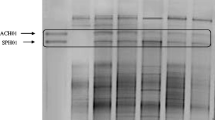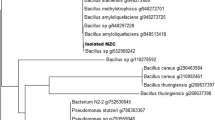Abstract
Polycyclic aromatic hydrocarbons (PAHs) are pollutants that are potentially carcinogenic, are widely distributed in the environment, and accumulate in soils. The peroxydisulfate anion strategy for the remediation of PAH-contaminated soils has attracted widespread interest, despite its negative effects on soil microbial activity as a result of oxidative stress and a decrease in pH of the soil caused by the treatment. The acidification caused by the process can itself affect the growth of the normal flora, regardless of the presence of PAHs. For this reason, it is necessary to identify microorganisms that are capable of developing in acidic environments and are sensitive to the presence of PAHs. The objective of the present study was to identify native acidophilic/acid-tolerant algae isolated from the Agrio River-Lake Caviahue system, Argentina, that could possibly be used as bioindicators of soil PAH contamination. Two of the three acidophilic species assayed were identified as potential bioindicator species. Cyanidium caldarium and Euglena mutabilis were responsive to PAH contamination in the tested soils, while the response of Keratococcus rhaphidioides was dependent on the type of soil. The use of acidophilic and cosmopolitan species, such as C. caldarium and E. mutabilis, as bioindicators is a promising first step for assays of PAH contamination in soils.

Similar content being viewed by others
References
APHA (1985) Standard methods for the examination of water and wastewater, 16th edn. American Public Health Association, Washington
Aprill W, Sims RC (1990) Evaluation of the use of prairie grasses for stimulating polycyclic aromatic hydrocarbon treatment in soil. Chemosphere 20:253–265
Baffico GD, Diaz MM, Wenzel MT, Koschorreck M, Schimmele M, Neu TR, Pedrozo F (2004) Community structure and photosynthetic activity of epilithon from a highly acidic (pH ≤ 2) mountain stream in Patagonia, Argentina. Extremophiles 8:463–473
Baker MD, Inniss WE, Mayfield CI, Wong PTS (1982) Effect of pH on the growth and activity of heterotrophic sediment microorganisms. Chemosphere 11:973–983
Baud-Grasset F, Baud-Grasset S, Safferman SI (1993) Evaluation of the bioremediation of a contaminated soil with phytotoxicity tests. Chemosphere 26:1365–1374
Beamud SG, Diaz MM, Pedrozo FL (2007) Summer phytoplankton composition and nitrogen limitation of the deep, naturally-acidic (pH ~ 2.2) Lake Caviahue, Patagonia, Argentina. Limnologica 37:37–48
Beamud SG, Diaz MM, Pedrozo FL (2010) Nutrient limitation of phytoplankton in a naturally acidic lake (Lake Caviahue, Argentina). Limnology 11:103–113
Bennett GF (1995) In situ bioremediation: when does it work? Committee on In Situ Bioremediation, Water Science and Technology. J Hazard Mater 42:109–110
Bezalel L, Hadar Y, Fu PP, Freeman JP, Cerniglia CE (1996) Metabolism of Phenanthrene by the white rot fungus Pleurotus ostreatus. Appl Environ Microbiol 62:2547–2553
Carter MR (1993) Soil sampling and methods of analysis. Canadian Society of Soil Science. Lewis Publishers, Boca Raton
Cerniglia CE (1992) Biodegradation of polycyclic aromatic hydrocarbons. Biodegradation 3:351–368
Flotron V, Delteil C, Padellec Y, Camel V (2005) Removal of sorbed polycyclic aromatic hydrocarbons from soil, sludge and sediment samples using the Fentons reagent process. Chemosphere 59:1427–1437
Forsythe W (1985) Física de suelos: manual de laboratorio 1º edn. IICA, San José de Costa Rica
Friedman GM, Sanders JE, Kopaska-Merkel DC (1992) Principles of sedimentary deposits: stratigraphy and sedimentology. Macmillan, New York, 717 pp
Gerhardt KE, Huang X-D, Glick BR, Greenberg BM (2009) Phytoremediation and rhizoremediation of organic soil contaminants: potential and challenges. Plant Sci 176:20–30
Germida JJ, Frick CM, Farrell RE (2002) Phytoremediation of oil-contaminated soils. Dev Soil Sci 28:169–186
González-Paredes Y, Alarcón A, Ferrera-Cerrato R, Almaraz JJ, Martínez-Romero E, Cruz-Sánchez JS, Mendoza-López MR, Ernesto O-O (2013) Tolerance, growth and degradation of phenanthrene and benzo[a]pyrene by Rhizobium tropici CIAT 899 in liquid culture medium. Appl Soil Ecol 63:105–111
Hill GJC (1980) Mating induction in Oedogonium. In: Gantt E (ed) Handbook of Phycological Methods. Developmental and Cytological Methods. Cambridge University Press, Cambridge, pp 25–36
Huang K-C, Zhao Z, Hoag GE, Dahmani A, Block PA (2005) Degradation of volatile organic compounds with thermally activated persulfate oxidation. Chemosphere 61:551–560
Huling SG, Pivetz BE (2006) In-situ chemical oxidation. U.S. Environmental Protection Agency, (EPA/600/R-06/072), 60 pp
IARC Monographs on the Evaluation of Carcinogenic Risks to Humans Volume 32. Polynuclear Aromatic Compounds, Part 1, Chemical, Environmental and Experimental Data (1983) World Health Organization, International Agency for Resarch on Cancer. France. 483 pp
Johnson DB (1998) Biodiversity and ecology of acidophilic microorganisms. FEMS Microb Ecol 27:307–317
Johnson RL, Trantnyek PG, O’ Brien Johnson R (2008) Persulfate persistence under thermal activation conditions. Environ Sci Technol 42:9350–9356
Kanaly RA, Harayama S (2000) Biodegradation of high-molecular-weight polycyclic aromatic hydrocarbons by bacteria. J Bacteriol 182:2059–2067
Kulik N, Goi A, Trapido M, Tuhkane T (2006) Degradation of polycyclic aromatic hydrocarbons by combined chemical pre-oxidation and bioremediation in creosote contaminated soil. J Environ Manag 78:382–391
Liang C, Bruell CJ, Marley MC, Sperry KL (2004) Persulfate oxidation for in situ remediation of TCE.II. Activated by chelated ferrous ion. Chemosphere 55:1225–1233
Maurino V, Calza P, Minero C, Pelizzetti E, Vincenti M (1997) Light-assisted 1,4-dioxane degradation. Chemosphere 35:2675–2688
Maxam G, Rila J-P, Dott W, Eisentraeger A (2000) Use of bioassays for assessment of water-extractable ecotoxic potential of soils. Ecotoxicol Environ Saf 45:240–246
Moretto LM, Silvestri S, Ugoa P, Zorzi G, Abbondanzi F, Baiocchi C, Iacondini A (2005) Polycyclic aromatic hydrocarbons degradation by composting in a soot-contaminated alkaline soil. J Hazard Mater 126:141–148
Murphy J, Riley JP (1962) A modified single solution method for the determination of phosphate in natural waters. Anal Chim Acta 27:31–36
N’Guessan AL, Levitt JS, Nyman MC (2004) Remediation of benzo(a)pyrene in contaminated sediments using peroxy-acid. Chemosphere 55:1413–1420
Nagasaka S, Nishizawa NK, Mori S, Yoshimura E (2004) Metal metabolism in the red alga Cyanidium caldarium and its relationship to metal tolerance. BioMetals 17:177–181
Nakatsu C, Hutchinson TC (1988) Extreme metal and acid tolerance of Euglena mutabilis and an associated yeast from Smoking Hills, Northwest Territories, and their apparent mutualism. Microb Ecol 16:213–231
Olaveson MM, Nalewajko C (2000) Effects of acidity on the growth of two Euglena species. Hydrobiologia 433:39–56
Pedrozo F, Kelly L, Diaz M, Temporetti P, Baffico G, Kringel R, Friese K, Mages M, Geller W, Woelfl S (2001) First results on the water chemistry, algae and trophic status of an Andean acidic lake system of volcanic origin in Patagonia (Lake Caviahue). Hydrobiologia 452:129–137
Satake K, Saijo Y (1974) Carbon dioxide content and metabolic activity of microorganisms in some acid lakes in Japan. Limnol Oceanogr 19:331–338
Técher D, Laval-Gilly P, Henry S, Bennasroune A, Martinez-Chois C, D’Innocenzo M, Falla J (2012) Prospects of Miscanthus x giganteus for PAH phytoremediation: a microcosm study. Ind Crop Prod 36:276–281
Temporetti P, Kimberley S, Pedrozo F (2013) Dynamics of phosphorus in sediments of a naturally acidic lake. Int J Sediment Res 28:90–102
Toplin JA, Norris TB, Lehr CR, McDermott TR, Castenholz RW (2008) Biogeographic and phylogenetic diversity of thermoacidophilic Cyanidiales in Yellowstone National Park, Japan and New Zealand. Appl Environ Microbiol 74:2822–2833
Tsitonaki A, Smets BF, Bjerg PL (2008) Effects of heat-activated persulfate oxidation on soil microorganisms. Water Res 42:1013–1022
Upham BL, Weis LM, Trosko JE (1998) Modulated gap junctional intercellular communication as a biomarker of PAH epigenetic toxicity: structure-function relationship. Environ Health Perspect 106:975–981
Whitton B, Diaz B (1981) Influence of environmental factors on photosynthetic species composition in highly acidic waters. Verh Int Verein Limnol 21:1459–1465
Wild S, Jones K (1995) Polynuclear aromatic hydrocarbons in the United Kingdom environment: a preliminary source inventory and budget. Environ Pollut 88:91–108
Acknowledgments
This study received financial support from ANPCyT (PICT 38114, 2008-1105), Universidad Nacional del Comahue (Program 04/B166), CONICET (PIP 11220090100013), and Universidad Nacional de La Plata (Program for trip 2012/13, res. 602/12).
Author information
Authors and Affiliations
Corresponding author
Rights and permissions
About this article
Cite this article
Diaz, M., Mora, V., Pedrozo, F. et al. Evaluation of native acidophilic algae species as potential indicators of polycyclic aromatic hydrocarbon (PAH) soil contamination. J Appl Phycol 27, 321–325 (2015). https://doi.org/10.1007/s10811-014-0334-2
Received:
Revised:
Accepted:
Published:
Issue Date:
DOI: https://doi.org/10.1007/s10811-014-0334-2




